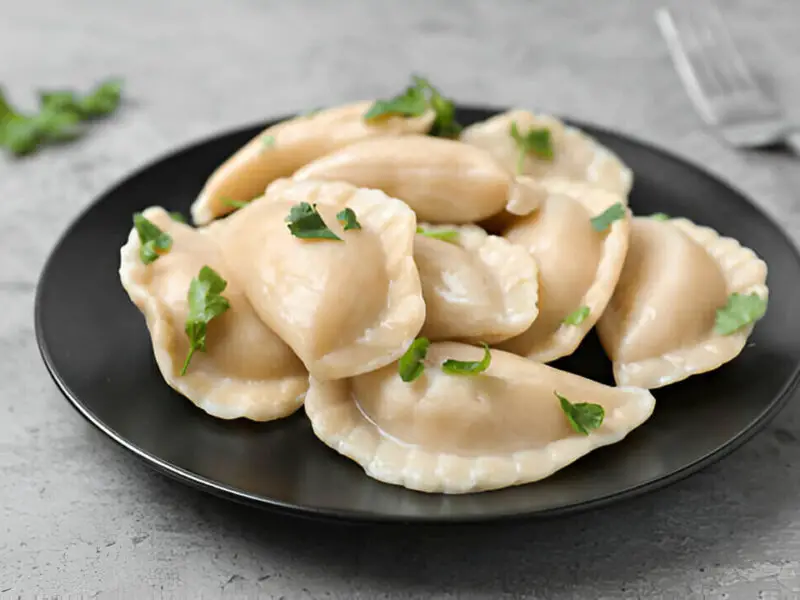You’ve seen them on menus; maybe you’ve tried a few different kinds, but let’s be real: dumplings are a delicious mystery wrapped up in a little doughy package. Whether they’re boiled, steamed, or pan-fried to crispy perfection, these pockets of flavors run the gamut from savory to sweet, meaty to veggie-packed.
But here’s the thing – with so many varieties from different cultures and cuisines around the world, you can’t just lump all dumplings together. A juicy Chinese pork and cabbage dumpling is going to taste a whole lot different than a plump Korean mandu bursting with beef and spices.
So let’s unwrap this delectable little “what do dumplings taste like” subject. Buckle up and get those taste buds ready as we dive into the wonderfully diverse world of dumplings. From the fluffiest Russian pelmeni to the mouth-watering tang of Vietnamese bánh bao, this is your guide to understanding what these flavor bombs actually taste like. Trust me, by the end you’ll be a total dumpling expert!
Where Did These Delicious Dumplings Come From?
While dumplings may seem like a simple concept – dough on the outside, tasty fillings tucked within – their origins are a bit harder to pin down. These little pockets of deliciousness have been around for centuries, crossing cultures and borders alike.
Some say the first dumplings were born in China, with surviving literature pointing to them gracing tabletops as early as the 3rd century. Others argue they originated in the Middle East or even date back to the Romans. No matter where they first popped up, one thing’s for sure – dumplings quickly became a global phenomenon.
Fast forward to today, and you’ll find dumplings are a beloved comfort food from Asia to Europe, the Americas and beyond. While certain dumpling styles are iconic to certain cuisines, like the trademark pleated crescent shapes in Russian pelmeni or the precocious throwing motion that gives Chinese jiaozi their cute puckered look, they all share some serious doughy DNA.
Dumpling Ingredients
Behind every great dumpling is a deceptively simple list of core ingredients that come together to create magic. While the fillings may steal the spotlight, don’t underestimate the humble dough that keeps everything deliciously contained.
At its most basic, dumpling dough starts with a mix of humble all-purpose flour and water. But as you’ll see, subtle variations and additions to this basic dough can unlock endless flavors and textures across global dumpling varieties.
Flour
The backbone of any good dumpling wrapper. All-purpose is standard, but some recipes call for bread flour or even wheat or rice flours to affect texture and tenderness. The proteins in the flour develop the stretchy, workable gluten that allows the dough to be rolled and pleated into neat little bundles.
Water
Provides moisture to hydrate the flour and bind the dough together. Some recipes call for scalding the water first or using wrist-turningly icy cold water to customize the dough’s elasticity.
Salt
An absolute must for adding flavor and regulating liquid absorption in the dough. The amount is crucial – too little and your dumpling will be bland, too much and it’ll be unpleasantly salty.
Fats
Bringing shortening, butter, lard or even vegetable oil into the mix creates dough with richer flavor and a desirably flaky texture. Fats also help dumplings stay moist and tender during cooking.
Eggs
A common addition in many European dumpling doughs, eggs build structure with their protein and enriching yolks create an ultra-luxe, silky texture. Some recipes use just the yolks.
Milk/Dairy
Using milk or yogurt in place of some liquid adds calcium for tenderness, sugar for subtle flavor, and fat for richness. Particularly popular in Eastern European varieties.
Baking Powder/Soda
Just a whisper of leavening helps dumplings get light and fluffy.
Aromatics
Certain varieties break from tradition by loading their dough with flavor builders like garlic, herbs, spices, cheeses, mashed potatoes or veggies for adding major oomph!
Mixing it All Up
The kneading and resting process is just as important as ingredients in determining a dumpling dough’s texture. An overly dense dough can create a thick, chewy shell while too light risks dumplings going soggy.
Most recipes simply direct folding together the dough using a wooden spoon or chopsticks before giving it a thorough knead until smooth and elastic. Then comes resting, which helps relax the gluten for easier rolling and folding.
Dumpling Fillings
While the dough provides the handy little package, it’s what’s on the inside that really counts when it comes to giving dumplings their signature flavors. And boy, do these fillings run the delicious gamut!
From tender, mouth-watering meats to crisp, punchy veggies, a well-crafted dumpling filling is like a beautiful symphony for your taste buds. Let’s take a deeper dive into some all-star ingredients that make dumplings so craveable across the globe:
Meats
At the classic protein-packed star, you’ll find everything from ground beef, chicken to tantalizing combos like pork and shrimp. The meats are typically seasoned with aromatics like garlic, ginger, green onions and the like to give the filling an incredible depth of flavor.
Veggies
Don’t underestimate the power of greens! Shredded or finely chopped veggies like cabbage, mushrooms, spinach, carrots, and more bring freshness, crunch and nutritious goodness to the party. They’re the perfect supporting act to all that satisfying meatiness.
Cheeses & Dairy
From the briny tang of feta or farmer’s cheese to the richness of mozzarella or ricotta, a little fromage can go a long way. Many Eastern European dumplings get their signature flavors from cheese fillings.
Herbs & Spices
The seasoning is where dumplings really get their cultural flair on. Warming spices like cumin, coriander and Sichuan peppercorns lend heat and earthiness. Bright herbs like cilantro, dill and parsley add zest. Don’t forget umami bombs like soy sauce and miso!
Wildcard Fillings

Let your imagination run wild because the world is full of funky and delicious dumpling surprises. Sweet versions dolled up with chocolate, fruit or sweet cheese? Yes please! Or maybe you’d prefer a savory version packed with smoky barbeque chicken or tangy buffalo chicken.
No matter what specific ingredients end up in your dumpling filling, you can be sure of one thing – when you cut into that first piping hot bundle, an explosion of scents and flavors will be unleashed onto your grateful taste buds.
The beauty is in the simple melding of so few ingredients into something so sublime. A great dumpling filling hits all the right notes – salt, fat, acid, heat. It’s the perfection of tastes and textures in every single bite.
What Do Dumplings Taste Like?
When you really stop to think about it, dumplings are edible ambassadors – little portable parcels that give us a delicious crash course in the traditions and flavors of cultures across the globe. And just like the wonderful diversity of countries and cuisines they represent, each variety brings its own unique flair to the dumpling party.
Chinese Dumplings (Jiaozi)
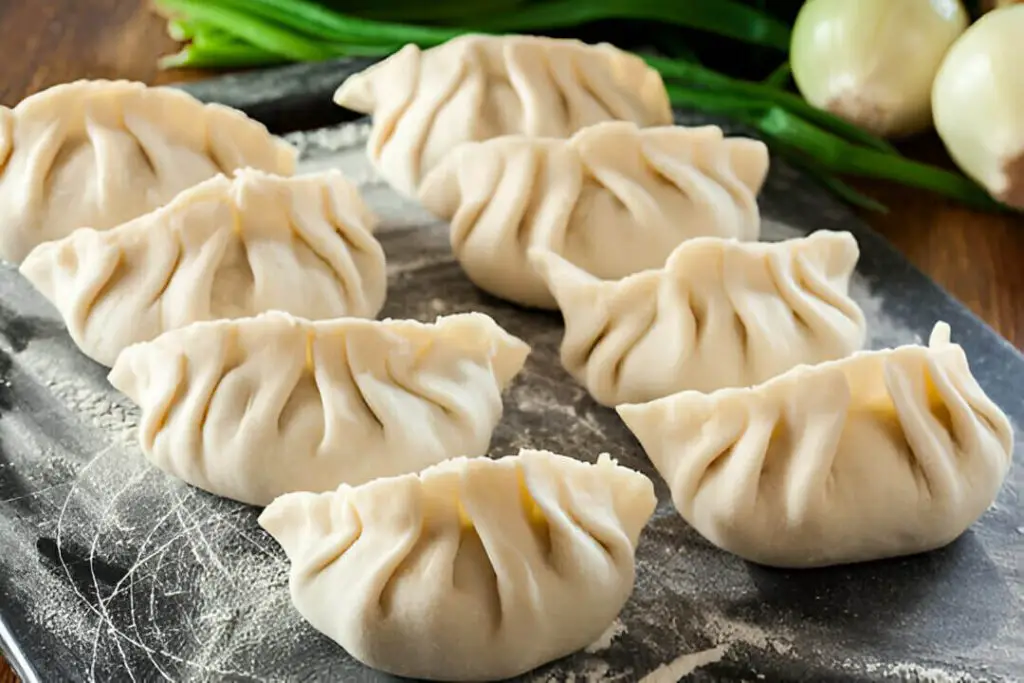
Arguably the OGs that started the worldwide dumpling obsession, these iconic little fellows pack a serious umami-punch. The classic juggernauts are plump pork and cabbage jiaozi—that rich, savory filling gets its signature lick of flavors from ginger, scallions, sesame oil, soy and white pepper. Pan-fried into golden pouches with lacy, crispy bottoms or simply boiled in bamboo steamers until delicate and translucent, these babies are pure tradition in edible form.
But don’t sleep on creative new jiaozi twists either! Juicy soup dumplings (xiaolong bao) are the luscious darlings of Shanghai, filled with rich pork aspic that bursts into a savory broth when you bite into the pillowy wrapper. Zheng jiao, or “marinade dumplings”, get their punch from an intense infusion of aromatic spices like star anise, cinnamon and Sichuan peppercorns mingled into the pork filling. Bottom line – Chinese dumplings never fail to bring the cozy, flavor-packed comfort.
Japanese Gyoza
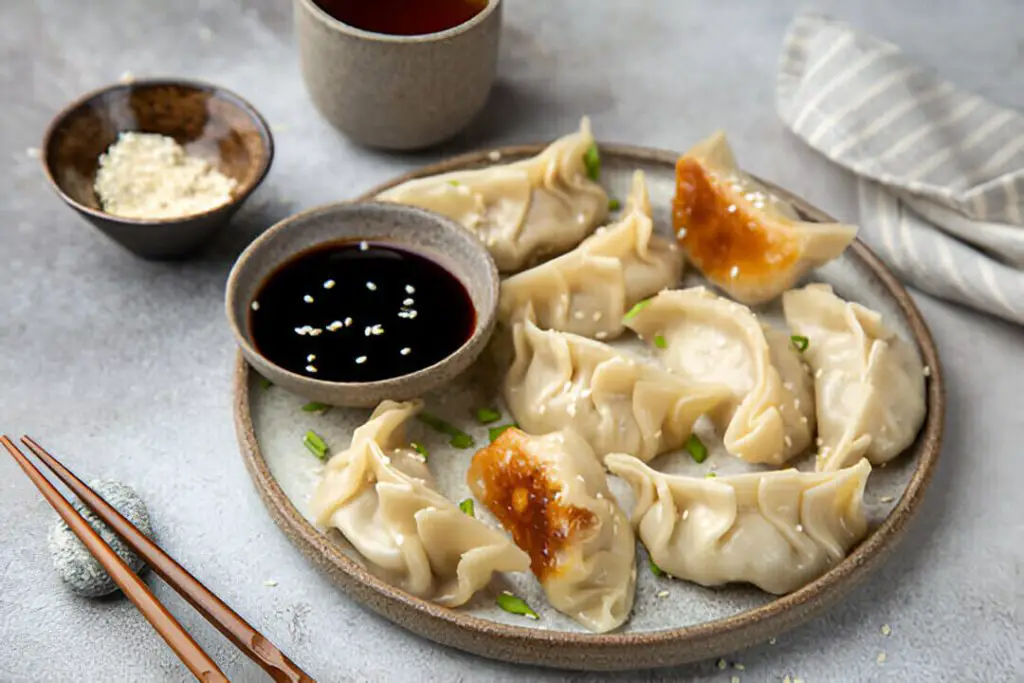
Deeply interconnected to their Chinese ancestors, gyoza offer a lighter, more delicate take on the classic pork and cabbage combo. The wrapper dough is rolled thinner and more delicate, while fillings skew toward simpler seasonings like garlic, ginger, green onion and sesame oil. But don’t let their refinement fool you – these plump half-moons of gingery, porky goodness are plenty addictive.
The real showstopper with gyoza is the cooking method. Pan-frying them into amber-crisp bottoms creates an incredible harmony of textures—a lacy, cracker-crisp crunch that gives way to the most juicy, slurp-able filling you’ll ever know. One taste of the gyoza-potsticker hybrid with its insanely salty-porky dipping sauce, and this iconic side dish from the izakaya (Japanese gastropub) immediately becomes your new go-to dumpling obsession.
Korean Mandu
Time to turn up the flavor! Korean mandu crank the seasoning with intense punches of savory garlic, pungent ginger and just the right kick of gochugaru chili flakes. A classic mandu stuffs seasoned beef or pork into the doughy envelopes, but get ready for curveballs like cheesy kimchi mandu, sweet-and-savory bulgogi mandu, or veggie varieties packed with mushrooms, sweet potato and spinach.
While mandu can be boiled, steamed or pan-fried, deep-fried versions are a major highlight. That shatteringly crispy shell and beef-forward filling is utterly irresistible, especially when dunked in a vinegary sweet-and-sour dipping sauce or tangy-hot mustard. For the full knockout mandu experience, eat them fresh out of the bubbling oil while the crunch is at maximum crispiness. Then prepare to have your expectations for dumplings forever raised!
Russian Pelmeni
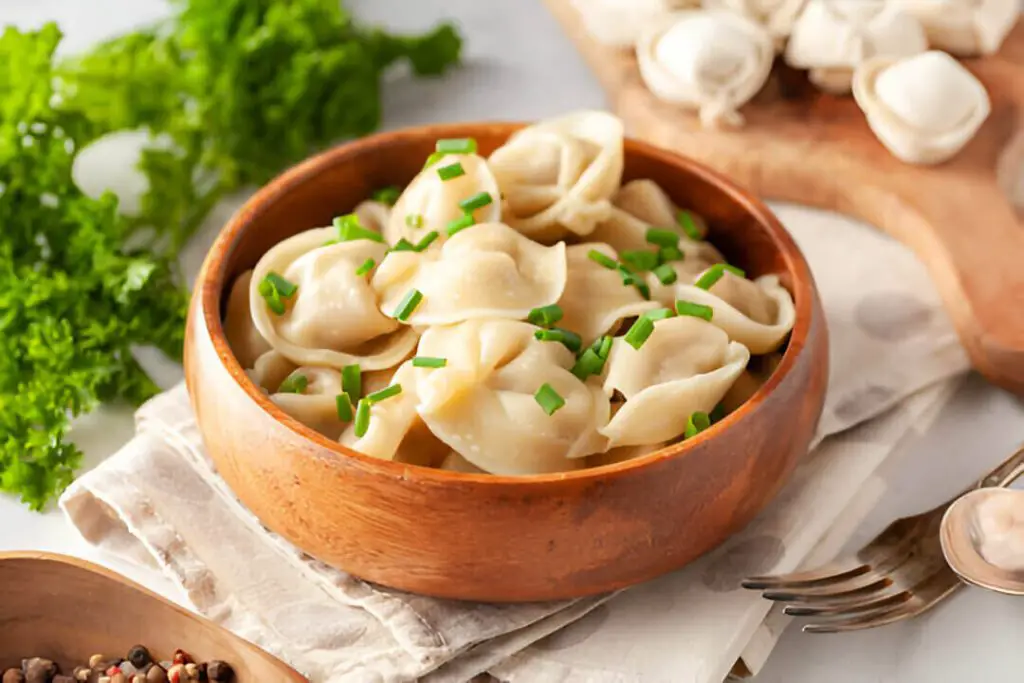
Leave it to the hearty Eastern Europeans to stuff their dumplings with belly-filling goodness. The doughy twists of Russian pelmeni are portly pasta pillows packed with robustly seasoned meat fillings that mean serious business. We’re talking ground lamb and beef sparked up with aromatic allspice, bay leaf, nutmeg, paprika and black pepper. Or rich blends of chicken and pork with sautéed onions, punchy garlic and fragrant dill.
Even vegetarian variations bring the flavor fireworks, combining potatoes, mushrooms, chard and melty cheeses into intensely savory bundles. However they’re stuffed, pelmeni always land somewhere exquisite between firm and pillowy in texture. Boiled in chicken or veggie broth until they float to the surface, then tossed with tangy sour cream, smoky bacon, vinegary chrain plum sauce or herbaceous dill butter, this is peak hearty comfort food in convenient nibble form.
Polish Pierogi

You know a dumpling is iconic when entire festivals celebrating its existence. And pierogi, the proud ambassadors of Polish cuisine, are just that legendary. These generous half-moons sport a tender yet chewy dough embracing luscious savory or sweet fillings that are somehow both rustic and refined at once.
In the savory court, you’ve got pierogi overflowing with fragrant caramelized onions and cakey Idaho potato, tangy brined farmer’s cheese or sumptuous ground meat bathed in smoky bacon crumbles. They beg to be panned up with zesty sautéed cabbage and peppers, then lavished with crispy fried bits. Sweet versions, from berry to sweetened cheese-curd to sugar-dusted cottage cheese, are like handheld pastries ready to satisfy your most intense dessert cravings.
Boiled to a firm tenderness or pan-fried until bronzed, pierogi embrace just the right chew and delicate doughiness so every bite captures dough, filling and embellishments in one supremely satisfying shovel to the mouth.
Italian Ravioli
While you may think of ravioli as just an upscale pasta, these Italian dumplings check all the boxes – a doughy exterior giving way to a succulent filling inside. Just one forkful combines the rich, nuanced flavors of Mediterranean ingredients like creamy herbed ricotta, spinach and nutmeg; sweet roasted pumpkin puree; hearty ground beef and pork bolognese; or luxurious mushroom and truffle.
Sauced up or served in broth, the tender-pillowy ravioli texture is clearly star of the show. But the interplay of fresh, bright pasta dough embracing robust fillings is what makes them irresistible forkful after forkful. From the comforting classic “cheese” to the wow-factor seasonal varieties, every raviolo is a little gift to be unwrapped and savored.
Indian Gujiya

These sweet, crispy half-moon shaped dumplings are a holiday favorite throughout India for good reason – one bite and you’re immediately transported to an exotic, aromatic paradise for your tastebuds! Picture a flaky, robust outer shell made crisp from frying that shatters to reveal an intoxicating paste of milk solids, fragrant with rose water, saffron and cardamon.
The filling, made from khoya (reduced and thickened milk) and dryfruits like cashew and raisins, brings intense milky richness with a caramelly toffee edge. Some gujiya varieties also add a thin veil of sugar syrup for mirror-shiny shells that crystalize into a sweet, crackly crust. Warmly spiced and intensely floral, these precious little packages are the perfect celebratory indulgence.
Vietnamese Banh Bao
These impossibly pillowy steamed buns would be right at home with the name “little clouds of heaven.” While plain bao varieties allow the puffy, cotton-soft dough to shine, filled banh bao take things to leveled-up heights of savory and sweet indulgence.
In the savory realm, you’ve got ground pork seasoned with warm five-spice or decadent barbecue pork filling the ethereally soft bun. Other varieties embrace funky-bright flavors like earthy mushroom and aromatic scallions, scrambled eggs with creamy pork floss, or vibrant bamboo shoots and Chinese sausage.
The sweet side doesn’t disappoint either. Banh bao stuffed with luscious sweetened red bean paste or punchy coconut jam play like the perfect intersection of a light dessert and handheld snack. One molten, dreamy bite reveals the beautiful contrast of a comforting steamed dough shell embracing an oozy, flavor-packed center.
Indian Samosas
You can’t talk iconic dumplings without giving samosas their due. The crispy, iconic fried pockets are unquestionably one of India’s most beloved snacks and appetizers. While they may look unassuming in their humble, triangular shape, that first explosion of warmly spiced potato, pea and cumin filling will rock your world.
At their core, samosas are all about that robustly seasoned vegetable stuffing – a lively simmered mix of russet potatoes, onions, peas, cumin, coriander, chili powder and more earthy spice goodness. The real game-changer is buttery layers of thin dough that fry up into the most destructibly crisp, flaky outer shell. One bite shatters into infinite crunch giving way to the molten, curry-charged interior.
But don’t sleep on the flavor spin-offs either! Keema samosas pack a meaty punch with their warm spiced ground lamb, beef or chicken fillings. Sweet samosas filled with sweetened chickpea flour, raisins, cashews and saffron provide a sugary counterpoint. However they’re stuffed, samosas are pretty much the ultimate portable snack – endlessly satisfying to nosh with your hands and ideal for dipping into fresh chutneys or yogurt sauces.
Turkish Manti
Leave it to the Turkish to put their own spin on dumplings. Manti are lush, bright bundles featuring a signature spiced meat filling draped in cool garlicky yogurt sauce and buttery brown sauce.
The dumplings themselves are delicate twists of gossamer-thin dough swaddling a robust lamb, beef or mixture filling perfumed with aromatics like mint, dill, sumac, chili and lemon. While typically boiled or steamed, it’s the contrasting drench of zesty yogurt and ruddy butter sauces that send manti over the flavor edge.
Manti instantly sings of sun-drenched Mediterranean cuisines, with the richness of the meat playing off the cooling tang of garlicky yogurt, all brightened up by zippy herbs and spices. Every bite offers layer after layer of flavors and textures – the slippery noodle dough, the savory meat, the velvety yogurt, the buttery sauce with crispy browned edges. It’s an intoxicating jumble that’s surprisingly refreshing yet still so comforting and indulgent.
Colombian Empanadas
If there’s one dish that captures the vibrant, soulful essence of Colombian cuisine, it’s got to be the gloriously portable, endlessly customizable empanada. At their most basic, these hearty stuffed pastries combine a robustly seasoned meat or veggie filling into a crackling crisp wheat or corn turnover crust. But the variations are positively endless!
On the savory side, you’ve got enviable fillings like spicy ground beef with tomatoes, onions and smoky cumin; juicy shredded chicken stewed in a creamy sauce with peas and potatoes; flaky saltfish accented by zippy sofrito sauce. Heck, even simple cheese empanadas are hard to resist with their gooey, stretchy interiors.
Not to be outdone, sweet empanadas like arequipe (sweet milk caramel), feisty pineapple or oozy guava and cream cheese provide a delightful sugary punch. No matter how they’re stuffed, empanadas are always a guaranteed flavor explosion. The crispy, lushly fried exterior gives way to molten fillings that beg to be eaten street food-style – out of hand with a zesty aji dipping sauce on the side.
Nepali Momo
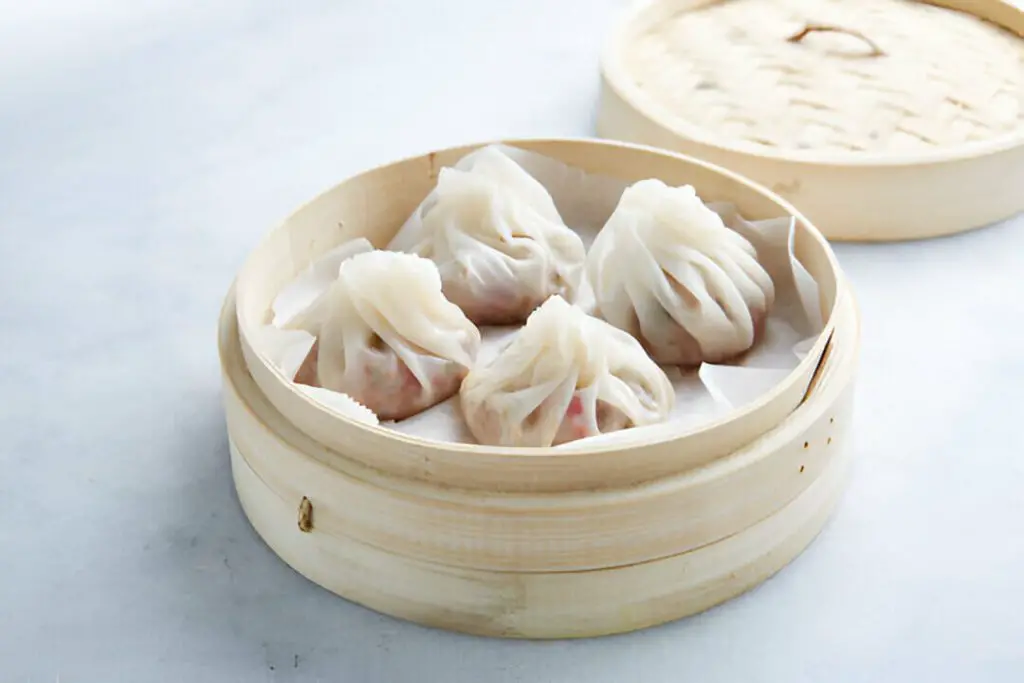
For such a compact bite, Nepali momos carry a serious punch of flavors and textures from their Tibetan/Nepalese roots. These plump, generously-sized dumplings pack a variety of savory meat or veggie fillings into a delicately doughy outer package.
The classic goat or chicken momo fillings embrace a host of warming spices like cumin, chili powder, ginger, Szechuan peppercorns and garam masala alongside aromatics like cilantro and scallions. Vegetarian versions are just as enticing, combining seasoned potato, cabbage, spinach or mushrooms into delightfully complex bites.
While steamed or pan-fried momos are divine in their own right, the real MVPs are the achaar (dipping sauces) that accompany each order. A zesty tomato-cilantro number, a tongue-tingling chili sauce or herbaceous mint sauce provide the perfect bright, spicy punctuation to the rich dumpling flavors.
For momo lovers, it’s all about the deeply savory combo of the juicy, aromatic filling encased in that smooth, slippery soft dough wrapper. Every bite practically begs for a dunk in those lip-smacking chutneys to add bursts of acid, heat and herbal refreshment against the dumplings’ warming spiced numbles. It’s the kind of multi-dimensional flavor bomb that will have you craving these beloved street food snacks morning, noon and night.
How to Cook Dumplings
You’ve got your perfect dumpling dough and a insanely tasty filling locked and loaded. But here’s the make-or-break moment – the cooking technique. Treat these doughy delights right, and you’ll be rewarded with sheer textural bliss in every bite. Overcook them or schlep the shoddy cooking method? Buckle up for gluey, doughy sadness.
From boiling to steaming, pan-frying to souping, the choices for how to cook your dumpling baby are splendidly diverse across global cuisines. Let’s dive into the delicious deets:
Boiling
One of the OG dumpling cooking techniques, boiling plump dumplings in salted simmering water until they float to the surface signals they’re done. You’re left with dumplings that are tender yet toothsome on the outside, while the hot water gently steams the filling until juicy perfection. Lazy person pro tip: frozen dumplings can go straight from the freezer to the pot for easy meals.
Steaming
This gentle method from China relies on bathing the dumplings in hot vapor to cook them through. Common for delicate pot sticker-style dumplings, the steaming process prevents burning while allowing wrappers to stay gossamer thin yet still slurp-ably soft. Pro tip: line your steamer with napa cabbage leaves or parchment to prevent sticking.
Pan-Frying
The signature sizzle and double-whammy crispy-bottomed texture of potstickers or Japanese gyoza relies on the pan-frying method. You start by browning the bottom of the dumpling in hot oil, then add a splash of water and steam them until cooked through, creating an irresistibly crisp-meets-tender contrast.
Deep-Frying
Bye bye, diet! Hello, hot, crispy, crunchy deliciousness. From classic empenadas to Chinese wontons or Japanese age dumplings, nothing beats the sheer joy of biting through a dumpling’s crackling deep-fried exterior into the hot, molten filling within. Do. Not. Skimp. On. That. Dipping. Sauce!
Baking
For an easy, fuss-free, one-and-done cooking method, baking dumplings in a hot oven gives you kitchen confidence. Just brush or spritz them with oil, bake until crispy, and boom! While not as delectably crispy as frying, this method creates a chewier, breadier texture in dumpling wrappers.
Simmered in Soup/Stew
Plop those little dough bundles into a simmering pot of broth or stew, and in no time they’ll be plump, tender and soaked through with incredible flavor. Common for Russian pelmeni, Polish pierogies, Ukranian varenikis and more. Pro tip: add frozen dumplings straight to the pot and simmer until floating.
Instant Pot/Pressure Cooking
Talk about a game-changer! Tossing frozen dumplings into an Instant Pot with a little water or broth will cook them through in a flash under pressure with zero babysitting. You’re left with dumplings that are incredibly light and almost souffle-like in texture.
Microwave
Hey, we’re not judging here! When those dumpling cravings strike hard and fast, give them a quick zap. Just space them out on a microwave-safe plate, add a couple tablespoons of water to create steam, cover loosely with microwave-safe plastic wrap and cook for 3-4 minutes (flipping once). Boom. Easiest, laziest way to dumpling nirvana.
Serving Dumpling
After all the delicious details we’ve covered on dumpling origins, ingredients, cooking techniques and iconic global flavors, it’s time to dial in on the main event – enjoying these luscious little bundles in all their glory! How you serve and present dumplings can elevate the whole experience from good to mind-blowingly great.
Whether hosting an epic dumpling feast or just satisfying a craving with a solo snack, it’s all about embracing the traditions while putting your own tasty spin on things. Let’s explore all the scrumptious serving possibilities:
The Awesome Dumpling Spread
Going all out with a dumpling party? It’s time to set up a full-blown dumpling bar! Arrange a diverse selection of dumplings on platters, steamer baskets or dim sum carts, encouraging guests to mix and match varieties.
Include both fresh and frozen dumplings to cover all the bases – steamed vegetarian dumplings, pan-fried potsticker or gyoza, boiled and brothy xiao long bao, deep-fried wontons and crispy rangoons. Label each type, and provide a rainbow of dipping sauces like chili oil, vinegar-soy sauce, ginger-scallion, sweet chili and mustard for customizing.
For heartier appetites, round out the spread with traditional accompaniments like simple sauteed greens, steamed rice, noodles or congee. And don’t forget refreshing palate cleansers like herb salads or vinegary cucumber mixtures between bites.
The Comforting Dumpling Bowl
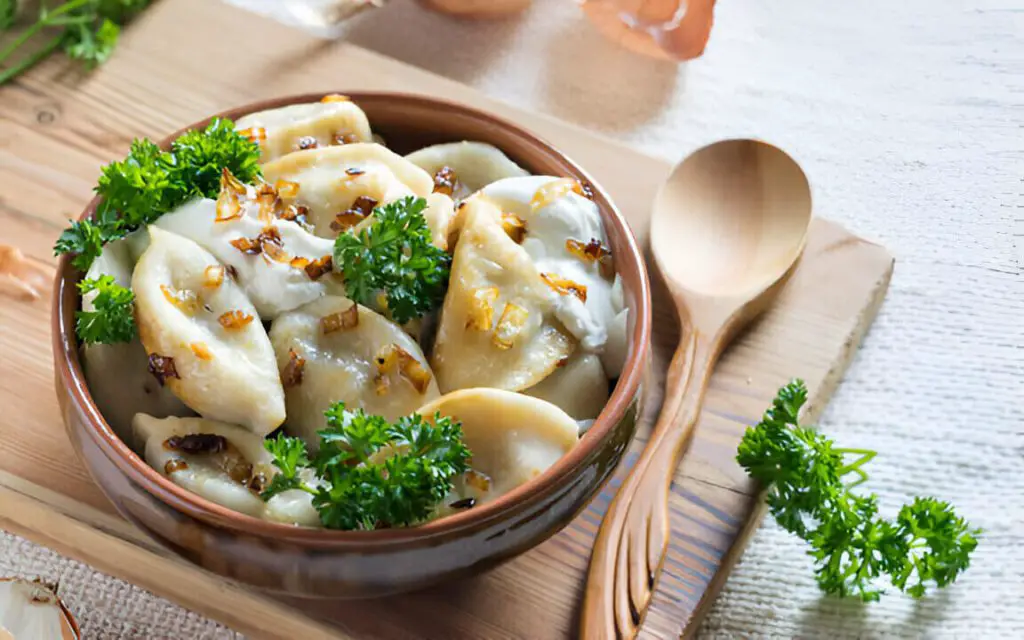
Craving the warm, cozy embrace of dumplings? Let them become the star of a soul-soothing meal by serving them Russian or Polish-style in a brimming broth bowl.
Load up on plump, chewy pelmeni or pierogi by adding them to a simmering chicken, beef or mushroom broth along with classic mix-ins like sour cream, dill and mushrooms. Or try Ukrainian-style with caramelized onions and bacon. Suddenly, humble dumplings become a sublime, slurp-worthy meal.
You can also give dumplings the tortellini or wonton treatment by adding them to traditional chicken noodle soup, minestrone or even chunky stews. Their plump texture and savory fillings add immense heartiness.
The Versatile Dumpling Starter
Don’t undersell the power of dumplings to be an impressive, yet unfussy appetizer or snack course. Pan-fried potstickers, gyoza or samosas make for prime beer-friendly grazing while momos, empanadas or pelmeni translate perfectly to hand-held starter bites.
Keep things traditional by serving hot dumplings straight from the steamer or frier with basic dipping sauces like soy sauce, chili oil or tzatziki on the side. Or elevate dumpling apps by plating them over creative garnishes and sauces. Think potstickers over gingery mustard greens, pelmeni with browned butter and herbs, or samosas with coconut chutney.
Even humbler boiled dumplings like pierogi can become a star when plated with fixings like caramelized onions, mushrooms and sour cream. It’s all about playing with textures, temps and flavors!
The Dumpling Remix
Want to have some fun with tradition? Put a creative spin on dumpling presentations by deconstructing, reimagining, or remixing them into novel culinary delights.
For a creative small plate, try an open-faced dumpling “naanchos” by frying up wonton wrappers into crispy chips, then topping with saucy fillings like curried chickpeas, barbacoa beef or mushroom ragout. You can also get playful with dumpling form factors, baking them into savory baked “pies”, pan-frying jumbo flat dumplings into crispy dumpling “pizzas”, or even hand-rolling delicate dumpling “buns.”
Don’t forget to leverage fillings in creative new ways – try samosa stuffing folded into hand pies, gyoza filling as wontons in soup, empanada picadillo reimagined as stuffed peppers or pierogi fillings in hand pies. Anywhere that calls for tasty fillings and dough, you can substitute and remix classic dumpling components.
The Cultural Significance of Dumplings
Sure, we could wax poetic all day about the incredible flavors and versatile cooking methods that make dumplings so universally delicious. But these beloved bundles of dough and fillings are more than just delightful eats – they’re edible ambassadors steeped in rich cultural traditions and significance across countless global cuisines.
At their core, dumplings represent culinary storytelling, with each unique shape, stuffing and preparation providing insight into the heritage and history of its respective culture. Let’s take a deeper look at how these humble pockets have become both cherished everyday foods and iconic culinary treasures in diverse communities:
China
Many believe Chinese jiaozi dumplings, with their crescent moon shapes, originated as an offering to ancient gods and ancestors during the Spring Festival (Chinese New Year). Their preparation and eating was seen as a powerful ritual to bring luck and wealth in the year ahead.
Today, making and enjoying dumplings together remains a beloved Lunar New Year’s Eve family tradition across China and within the global Chinese diaspora. The act of meticulously filling, folding and crimping each dumpling brings multigenerational families together to bond over shared symbolic foods and hopes for the future.
Russia, Ukraine & Poland
In Slavic cultures like Russia, Ukraine and Poland, dumplings like pelmeni, vareniki and pierogi have been humble yet immensely satisfying everyday staples for centuries. Peasant foods created to stretch limited pantry ingredients, these straight dough parcels stuffed with basic fillings like potatoes, cabbage and meat provided sustenance and comfort.
While the specific shapes and fillings vary by region or even household tradition, dumplings were (and still are) viewed as an essential part of the domestic arts mastered by homemakers. Learning the art of dumpling making from mothers and grandmothers remains an important rite of passage in these cultures.
Jewish Diaspora
For Jews dispersed across the globe, kreplach (twisted dough pockets) and kreplachin (smaller versions) became a way to maintain culinary ties to Eastern European roots while adapting dumplings traditions to new homes. Fillings evolved to reflect what was available in new countries, with meat, potatoes and onions being constants.
During holidays like Purim, these dumplings take on special symbolic meaning – the twisted crimped shape is said to resemble the knotted binding used by the wicked Haman in the Purim story. In Judaism, eating kreplach was an important way to never forget cultural identity and history.
India
In India, dumplings like samosas and gujiya carry deep-rooted significance in celebrating major holidays and festivals. Samosas, the iconic fried and stuffed savory pastry, are Inextricably linked to the celebration of Navratri, honoring the divine feminine through food. Making and sharing these spiced potato or meat-filled pockets is a sacred ritual.
Meanwhile, the sweet gujiya is an essential treat during the springtime festival of Holi, ringing in the new year by exchanging these fried khoya (milk solids) pastries between loved ones as an embodiment of love and friendship.
Italy
For all their simplicity, Italian stuffed pastas like ravioli carry symbolic meaning related to wealth and fertility. Their plump, rounded shapes stuffed generously with fillings are seen as representations of the “ricci” or belly – signs of abundance, nourishment, prosperity and fruitfulness. No wonder they’re showpiece dishes at holidays and celebrations!
In Liguria, the iconic pansotti pasta (similar to ravioli) with its tortellini-like striped swirl shaping and walnut filling is thought to represent the local hilltop villages when viewed from above. These intricate details speak to the pride of place and cultural identity.
Across the board, these global dumpling delicacies reveal cultures’ deeply held traditions of fortifying the body, celebrating major festivals, passing down heritage through food, and signifying important symbols of community connectedness.
FAQs: What Do Dumplings Really Taste Like?
What’s the basic flavor profile of a dumpling filling?
At their most basic, dumpling fillings tend to have a richly savory, umami-packed flavor profile reminiscent of delicious ground meat gravies or stews. The bases are usually seasoned ground proteins like pork, beef, chicken or lamb, combined with aromatics like onions, garlic, ginger and scallions. From there, the flavor kaleidoscope expands with soy sauce, sesame oil, vinegars, herbs, spices and more.
Do all dumplings taste the same?
Definitely not! While savory meat and veggie fillings create that familiar homey savoriness, the specific ingredients and seasonings used impart a huge range of flavor nuances. Chinese dumplings might spotlight ginger, garlic and sesame, while Korean ones kick it up with fiery gochujang. Indian dumplings like samosas hit big on warmly spiced curried potatoes and peas. There’s an entire delicious universe of flavors to explore!
Are steamed dumplings bland and boring?
No way! Just because steamed dumplings have a more delicate texture doesn’t mean they’re lacking in the flavor department. In fact, gently steaming allows the pure, clean tastes of premium fillings to really shine. Xiao long bao (soup dumplings) are the perfect example – that luscious pork aspic broth is amazingly concentrated. When dipping sauces like soy sauce, vinegar, chili crisp and scallions get involved, you’re in for a serious flavor bomb.
What about veggie and seafood dumplings?
Move over meat – veggie-stuffed dumplings are just as craveable! Mushroom, spinach, cabbage, carrot, bean and potato varieties have a wonderful earthiness when seasoned properly. Throw in aromatics like chives, garlic, ginger, pepper flakes and you’ve got super satisfying meatless bites. Seafood dumplings can be sublime too, from shrimp har gow to cod or crab xiao long bao. The sweet brininess of the fillings complements the wrappers perfectly.
Can sweet dumplings ever be savory?
You betcha! While dessert dumplings stuffed with fruits, sweetened beans, nuts and spices are delightful, don’t sleep on sweet-savory crossover dumplings. Chinese dumplings filled with candied squash are wonderfully balanced by hints of soy and rice vinegar. Korean mandu might have fillings of beef short rib caramelized with a touch of brown sugar. Sweet fillings like red bean can have a subtle salty edge too. It’s all about nuanced sweet-savory interplay.
What do veggie dumpling dough and wrappers taste like?
Most classic dumpling wrappers have a neutral, wheaty fresh bread or pasta dough flavor allowing the fillings to be the real rock stars. However, some wrappers can contribute more punch on their own. Korean mandu wrappers have a subtle nutty sesame taste, while Chinese wheat doughs can have a nice egginess. Buckwheat or veggie-infused wrappers bring their own earthy notes too. So while dumplings aren’t all about the dough, the wrapping itself can add some great foundational flavors.
Do dipping sauces change dumpling flavor drastically?
You bet! While delicious on their own, part of the dumpling fun involves customizing flavors with a variety of dipping sauces. Plunging a juicy dumpling into a pool of vinegar-spiked soy sauce brings out some serious umami depth. Nutty tahini sauce makes veggie dumplings sing. Zesty garlic-herb sauces can cut through the richness of meat fillings. Hot mustard sauces, sweet chili crisp – the dipping options are endless for highlighting flavors or providing a burst of contrast. Dumplings do double duty as both the delicious main event and the saucy blank canvas!
How do boiled/steamed dumplings differ in texture from fried ones?
Boiled and steamed dumplings tend to have a softer, more delicate texture with a slight chew from the dough. The fillings stay moist and juicy. Fried or pan-fried dumplings develop an incredibly crispy, flaky outer shell that provides an amazing textural contrast to the tender filling inside. It’s the difference between slurpable pillows versus crispy pouches.
What makes soup dumplings (xiao long bao) so special?
Soup dumplings contain a rich, concentrated gelatin-based broth inside along with the traditional pork filling. When steamed, this aspic broth melts into an incredibly luscious, slurpable soup cradled inside the dumpling skin. It’s an amazing interplay of the juicy soup, tender meat and delicate dough in every bite.
Are all dumplings heavy, greasy or fried?
Not at all! While crispy pan-fried potstickers and samosas are insanely delicious, there are plenty of lighter, fresher-tasting dumpling varieties. Steamed dumplings like siu mai, har gow, manti and momos avoid any oil. Boiled dumplings like pelmeni and vareniki have that comforting starchiness without excessive grease. It all depends on the cooking method.
How do different proteins affect dumpling flavor?
The types of proteins used for fillings completely transform the overall taste. Pork is classic and brings a rich, porky savoriness. Beef has a hearty, beefy unctuousness. Lamb provides an earthy, gently gamey note. Chicken is lighter and more neutral. Seafood fillings contribute a wonderful sweet brininess. Even plant-based dumpling fillings like mushrooms and beans have their own nuanced savory umami notes.
What makes Korean mandu taste so distinct?
The key flavors in classic Korean mandu dumplings come from ample amounts of garlic, ginger, scallions and fiery gochugaru chili flakes or paste blended into the meat fillings. This provides a punchy savoriness with a lingering gentle heat. The wrappers can also have a light sesame nuttiness.
Can dumplings be spicy?
Absolutely! Certain regional dumpling varieties lean into spicy seasonings big time. Szechuan Chinese dumplings bring the tongue-tingling heat from Sichuan peppercorns and chili oil. Spicy Korean mandu get their kick from gochujang. Indian samosa fillings can be redolent with curried warmth from coriander, cumin and cayenne. Even XO sauce-drenched Hong Kong-style dumplings deliver explosive savory heat.
What about dessert dumplings – are they too sweet?
Not necessarily! While sweet dumplings filled with fruits, sweetened beans or nutty pastes can be quite sugary, many have a deft balance of flavors. Sesame seeds or coconut add lovely earthy notes to offset sweetness. Subtle floral aromatics like rose or orange blossom water add nuance. Some even have a background salinity that keeps things from being cloying. Portion sizes tend to be modest too.
What gives some dumpling doughs a yellowish hue?
The distinctive yellow color in certain dumpling doughs usually comes from the addition of egg yolks, which enriches the dough and gives it that lovely burnished tone. Turmeric can also lend a sunny hue to Indian samosa doughs. The natural yellow pigment in ingredients like carrots or sweet potatoes can subtly tint some dumpling wrappers too.
Final Words
No matter the style, every bite of a dumpling promises to be a delicious journey of flavors and textures. With so many variations in fillings, seasonings, cooking methods and traditions, these beloved bundles are endlessly tasty to explore!
